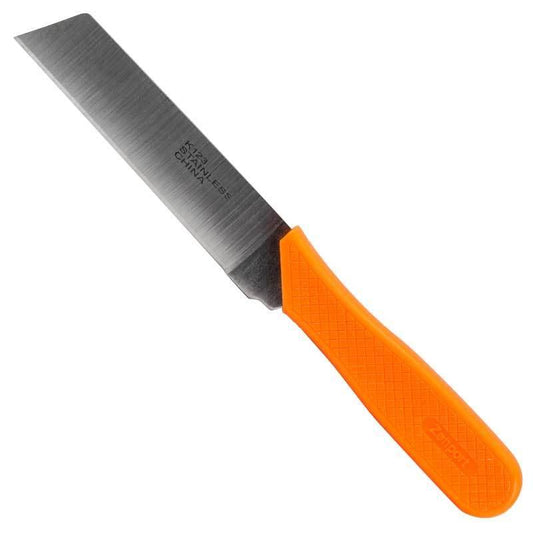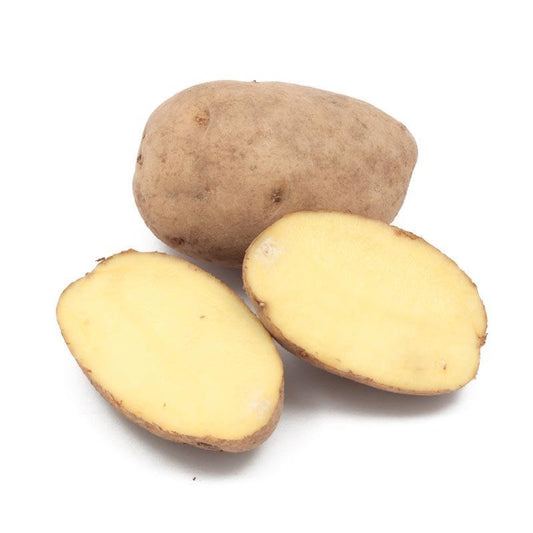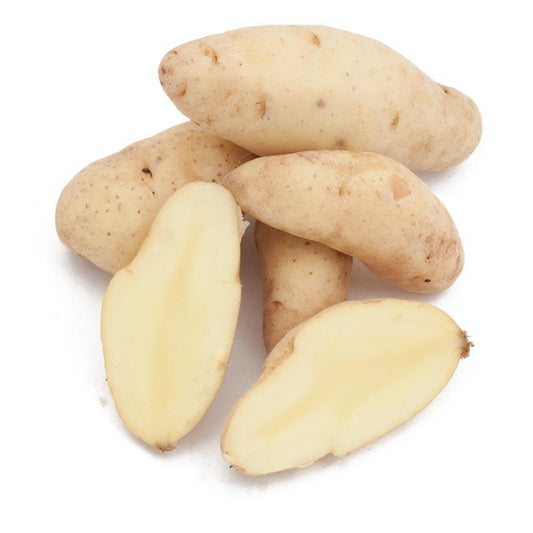The fundamental considerations and subtle nuances of growing and caring for seed potatoes are beyond the scope of this introduction to plant care. Please see our Resource Center where we offer additional instructional videos and articles, as well as our bookstore.
Receiving Your Potatoes
Please be sure to open your package of seed potatoes on the day it is delivered, and inspect them right away. If some are sprouting, handle them carefully to avoid damaging the sprouts. If you cannot plant right away, store the potatoes in a dark, cool place with good humidity and ventilation.
Special Note: Newly dug seed potatoes may not sprout easily. If you have received your seed potatoes in the fall they have been recently harvested, they are most likely dormant and must be treated to “waken” them. To induce sprouting, put potatoes with apples, bananas, or onions in a paper bag in a warm room (70°F). Ethylene gas given off by the fruits will initiate sprouting.
Make sure you pre-sprout them before planting so you are sure they are out of their dormancy and ready to grow. Otherwise please put the tubers in a paper bag and refrigerate for 2–4 weeks. Even with treatment, potatoes may not sprout until spring.
If you have received your seed potatoes in the spring, they are probably already sprouting and ready to plant.
Preparing the Seeds
Greening or Chitting: European market growers always pre-sprout their early potatoes for stronger, quicker stands and higher yields. This “greening” or “chitting” process is not necessary but is easy to do. Just spread the potatoes in open flats, seed end up. The seed end has the greatest concentration of eyes or growth buds and is the area where the strongest sprouts form.
Plan to expose the potatoes to moderate light and 60–70°F for one to two weeks. Potatoes smaller than 2” can be planted whole. Larger potatoes are cut into 1–2 oz. pieces, each containing 2+ eyes.
Next, dip the cut ends into dry wood ash to callous them or spread the pieces one layer deep, away from direct sun, for a day to cure.
At this time do not allow pieces to shrivel. Callusing is especially important if you are planting into fairly damp or cold soil.
Preparing the Bed

Potatoes prefer a pH range of about 4.8 to 5.5 and fertile, fairly weed-free soil. Scab is less of a problem if the pH is less than 6.0. Seed potatoes prefer sandy loam but will grow in a wide variety of soil types if the soil is well cultivated and well drained. The soil should be at least 45°F when you plant.
Potatoes require adequate nitrogen, potassium, phosphorus, magnesium, and calcium. Home gardeners should fertilize as they would a vegetable garden and better yet with a fertilizer that has more phosphorus in the mix (the middle number of the N-P-K number).
A fertilizer blended for flowers and bulbs is a good choice as well as one for acid loving plants. Potatoes do well with more phosporus in the mix than nitrogen. You can also supplement your all purpose fertilizer with a little bone meal. When adding fertilizer with higher phosphorus, put it in the hole with the potato piece for best results.
For an easy start on the right nutrients and soil conditioners, browse our Fertilizers & Growing Supplies collection—organic fertilizer blends, bone meal, potting soils, and other essentials to build healthy, low-pH soil for strong tuber set.
Important Note: High quality, aerobic compost, low in wood or rice byproducts, is preferable to manure as a fertilizer. If you must fertilize with manure, be sure it is well-aged and that it is incorporated shallowly into the soil at least 3–4 weeks before planting, otherwise the process of soil digestion will deprive the germinating potatoes of vital nutrients and water.
Do not fertilize with fresh manure, as this can cause scab. One of the best ways to prepare the ground for potatoes is to cover crop. Cover crops or “green manures” greatly improve the soil’s tilth, organic matter, microbial activity, and water holding capacity, and significantly increases nutrient availability for the next crop.
Legume cover crops (peas, vetches, clovers, alfalfas, etc.) have the unique ability to extract nitrogen from the air and return huge amounts of it to the soil in plant-available form. Rye, buckwheat and sweet clover mine insoluble phosphorus from the earth and return it in plant-available form. In most areas, a cover crop of our Summer Soil Builder Mix, which contains cowpeas (for nitrogen) and buckwheat (for phosphorus), will provide an easy and cost-effective way to prepare the ground for fall potatoes.
To prepare for spring potatoes, many home gardeners like to fall plant our Soil Builder Mix. For more information, see our article on Cover Crop. Wait to plant potatoes (or vegetables) for 2-4 weeks after turning under your cover crop, to allow time for it to break down in the soil.
Planting & Growing
To begin, hoe a shallow furrow (3 inches wide and 3 inches deep). Gardeners can space the rows 20–26” apart, but farmers might want to make them 30–36” apart. Space potato seeds, eyes up, 12” apart in the rows, and immediately rake 3” of loose, fine garden soil over them.
Do not plant the potatoes any deeper than 3 inches. The new potatoes will grow above the seed piece, so “hilling up” is necessary to provide sufficient friable soil and to protect the new potatoes from full sun exposure.
About 2 weeks after planting, when the plant shoots are 4–5” high, rake a good mound of soil around them, leaving about 1” of shoot exposed. In 2 to 3 weeks, hill again if necessary, taking care not to damage the plant’s roots.
Please be certain to keep the soil moist and irrigate if necessary. Mulch thickly with straw if heavy frosts are a factor. Another approach, valued for the clean, easy dig it provides, is to grow your potatoes in straw.
Do not set a trench, just lay the seed on the loosened soil and cover it with 6” of straw. As sprouts appear, keep mulching with straw. You must provide enough mulch (10–12”) to fully protect the new potato crop from sunlight.
Sunlight will green the potatoes, making them unfit to eat.
At harvest time, just pull back the mulch.
Growing Potatoes in Containers

Potatoes are easily grown in containers and the only requirement is that they have good drainage and should be at least 3’ high. It is a good idea to use at least a 15 gallon container (try a 15 gallon Smart Pot.) The best potato varieties to grow in a container are mid to late season ones and just a note, russets do not size up as well if grown in a container.
The best growing medium is half potting soil, half compost. Do not use animal manure compost unless it has been well aged as this can lead to scab development.
You can also use half peat instead of compost. This is especially good since potatoes like a low pH soil. Follow the previous directions for cutting and drying out the pieces.
Put the seed potatoes in about 8” of soil mix and space the pieces about 8-12” apart with the eyes up. Cover with about 6” of soil. As the potatoes grow you should fertilize about twice a month. Water deeply whenever the first 1-2” of soil feels dry.
An all purpose fertilizer can also be used in combination with bone meal or bulb tone which provide the phosphorus the plant needs to develop nice tubers.
As the tops grow you should add more soil on top (hilling), but leave at least 3-6” of the plant showing. A layer of mulch like straw can added to the top of the soil to reduce moisture loss.
Potatoes are ready to harvest when the tops have yellowed and died back, usually in the fall. Lay out a tarp and dump out the container, a screen or sieve can be used as well to make finding the tubers a little easier.
Harvesting
Spring-planted, early varieties will be ready in about 50–60 days. For maximum freshness, dig only what you can eat in 2 days. Do not eat green potatoes, as they contain the toxic alkaloid solanine.
Later varieties, intended for winter storage, should be “matured.” Let frost kill the vines, or kill them by scything, flaming or mowing them.
Take care not to pull up the potatoes, which should stay in the ground 2 more weeks to “set the skins.” After harvest, store at 36–40°F in dark, well-ventilated conditions. High humidity (80–90%) is also important. Arrange the potatoes in small piles, to improve ventilation, and cover the piles with burlap sacks, newspapers, etc. to reduce spoilage caused by condensation.
Conclusion
For gardeners and farmers looking to expand beyond berry crops, our seed‑potato selections offer high quality and versatility. Browse Seed Potatoes to explore heirloom and classic varieties that are perfect for your spring garden or storage harvest. Prefer something planted just with warmer soil? Check out our Spring Potatoes collection — these are ideal for late winter or early spring planting when soil temps allow. Use these collections alongside your blueberry planting to diversify your garden, ensure year‑round harvests, and maintain soil health with varied crop rotations.






